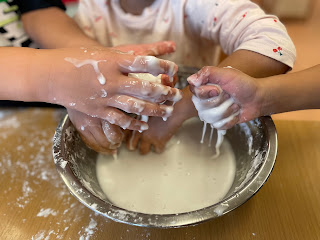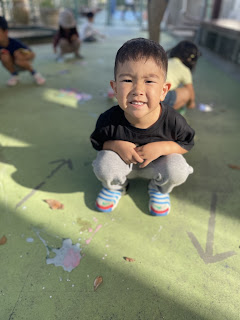Sometimes the best learning happens in the midst of what looks like chaos.
Don't be afraid to get messy.
-Leah Ross Henry
A big part of experimentation is allowing room for the mess to happen. In fact, mess plays a big role in the progress and success of scientists, as it allows room for exploration and for mistakes to happen.
In the Early Years, messy play is an essential experience for children as it helps them to develop their brain's capacity to connect with their environment through their senses -- and of course, it's adds in an element of fun.

According to learningismessy.com,
"Learning is often a messy business. Messy learning is part trial and error, part waiting and waiting for something to happen, part excitement in discovery, part trying things in a very controlled, very step by step fashion, part trying anything you can think of no matter how preposterous it might seem, part excruciating frustration and part the most fun you’ll ever have. Time can seem to stand still – or seem to go by in a flash. It is not unusual at all for messy learning to be… um… messy! But the best part of messy learning is that besides staining your clothes, or the carpet, or the classroom sink in ways that are very difficult to get out … it is also difficult to get out of your memory!"

This week in Kindergarten 2, we found ourselves in a messy situation as the classroom erupted in productive chaos and a feast for the senses. We learned about mixtures through experimentation and anchored our experiments on this wondering:
What will happen we add materials together? Can we still easily separate them?
Coming from our experiment on separating metals from other materials, of course the children said, "yes!" After all, they had a tool -- a magnet -- to help them with the not-so-daunting task. This time around, I gave them a variety of solids to add to a new element: water.
We began our experiment by recalling what it means to add and separate things. One of the children said, when we add, we put things together. But what does it mean to separate things? The children couldn't quite put it into words so we used some of the bottle caps that Emma shared with us to demonstrate what it means. They took divided the pile of caps into two: the white caps and the blue caps.
We discovered that to separate means to move things apart.
I asked them, "Do you think it's easy to separate the bottle caps from the water if I put them all together in a bowl?" The answer was a resounding yes. They simply picked the floating caps from the water using their hands.
I gave them a harder challenge. "What if we were to put the rice in water? Do you think we can easily separate the two things?" Some of them said yes, the others were not so sure. One of the children who said no shared that it's harder because the rice grains are smaller than the bottle caps -- which, if I may say, is a brilliant theory. 😀
We tried separating the rice grains from the water with our own hands and it was truly more challenging this time around. So we decided to use a new tool: a sieve. I asked the children to describe the tool and they said that it has small holes where the water will pass through and the rice grains will be collected. We tested our theory, and of course, it is right!
We continued the experiment the next day and this time around, instead of water, I added rice grains and sugar together. They all agreed that using their hands to separate the rice from the sugar is for sure a hard challenge to accomplish. The children used the sieve once again but it wasn't as easy as separating the rice grains from the water.
After much thought and experimentation, we discovered that we can actually use the water to dissolve the sugar, and eventually separate the rice grains from the sweet water with the sieve.
It was so cool to try out different things to make the separation process easier!
After learning that some solids dissolve in liquid (another property of matter! 😀) I introduced the children to another powdery solid: starch. While it looks similar to sugar, the way it reacts to the right amount of water is slightly different.
First, we tried feeling it with our hands. The children loved the fine texture of the potato starch!
Then we mixed it with just the right amount of water.
Voila! Introducing, the oobleck. This is a funny little piece of matter as it reacts differently depending on how you touch it. With a softer touch, it turns into a gooey mess. “Just like slime!” the children said. Just like slime, indeed. When you touch it with stronger force, it becomes a solid block of mass. You can even run on it unscathed if you have a big enough tub and a large supply of starch! The children absolutely loved it! We couldn’t separate the water from the starch but we discovered that if we leave it out, the water disappears, leaving just the starch behind!
We didn’t want our oobleck to go to waste so we decided to experiment on it further. We got our favorite watercolor liquids and transformed our plain oobleck into oobleck paint!
We used our oobleck paint to create our own oobleck monsters — just in time for Halloween!
Introducing, our oobleck monster friends:
Kai
Luna
Veronica
Daniel
YiChen
Amaru
Suzu
Emma
Louis
Amidst the messy classroom, gooey monsters with a kind heart and a playful spirit were born. Imaginations were brought to life and theories were given meaningful answers. Along with the mess and the chaos that ensued this week, core memories were made and meaningful learning took place.
Have a wonderful Autumn break, everyone.
May you also find the beauty in the mess.
Your Kindergarten teacher,
Pam















































Comments
Post a Comment